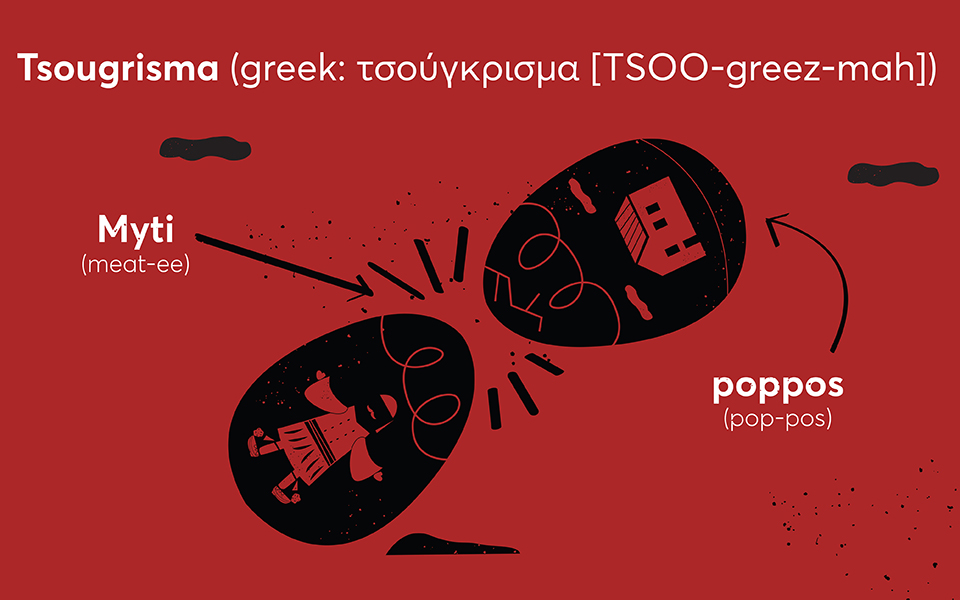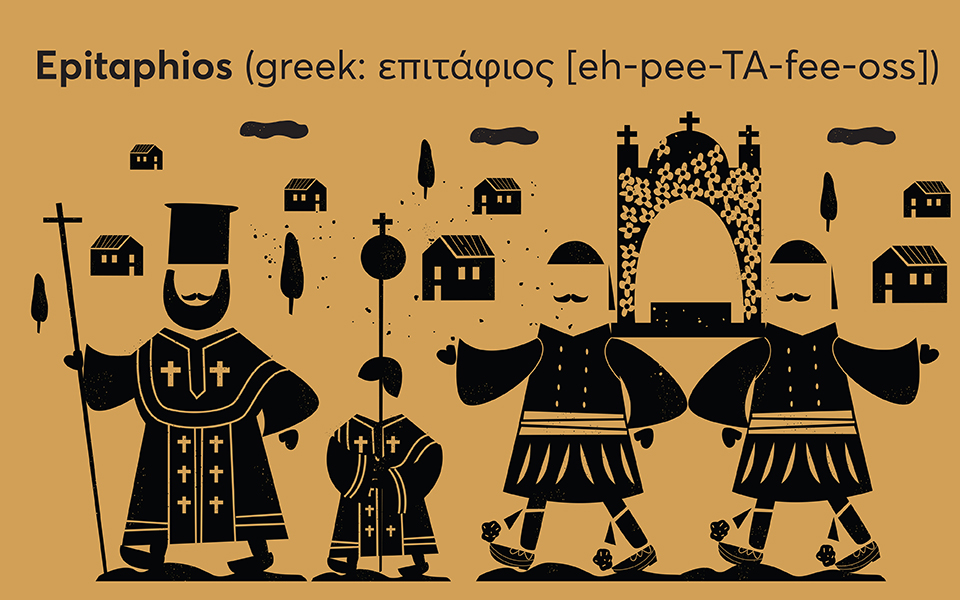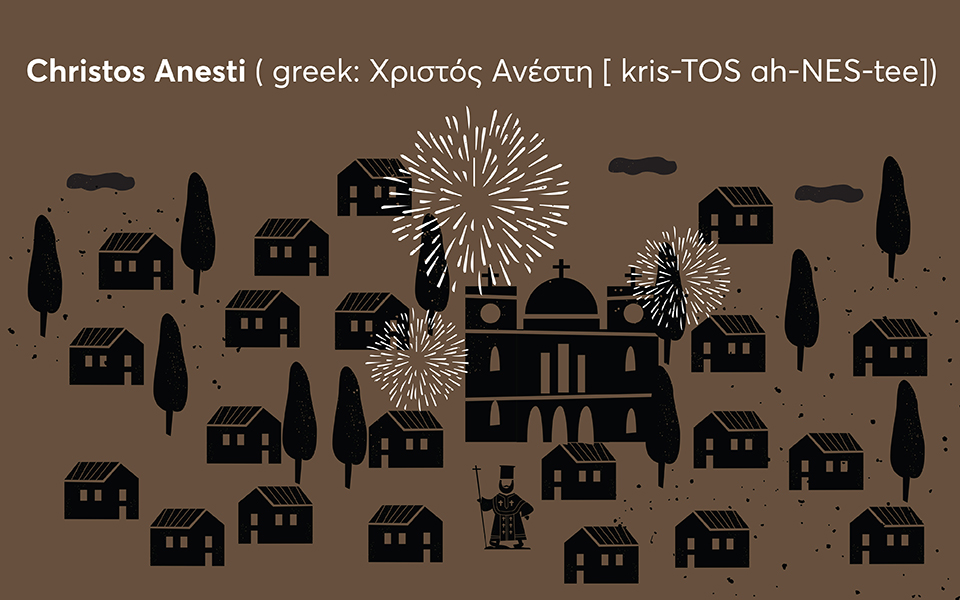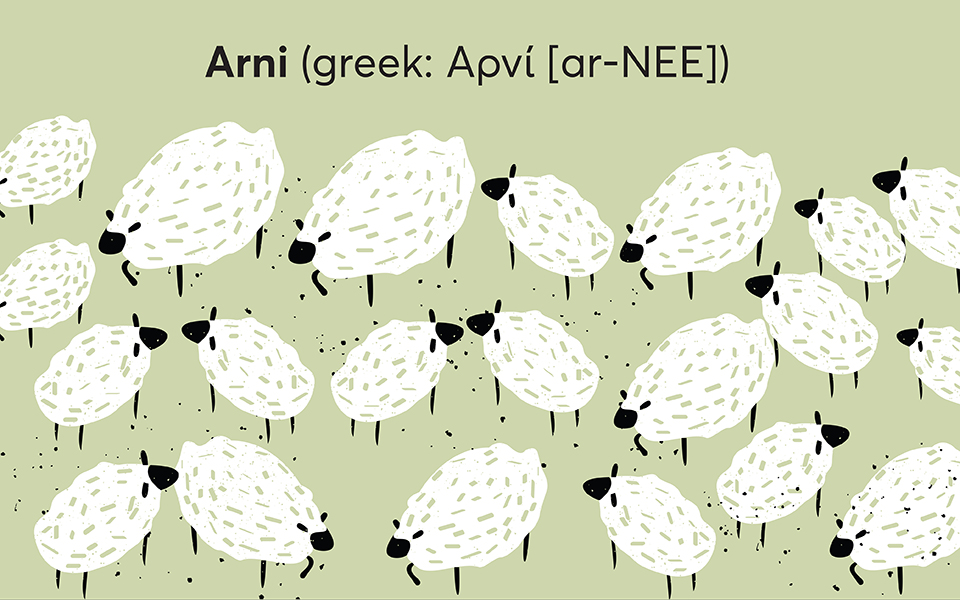Easter in the Mystical Castle of Monemvasia
In the castle town of Monemvasia,...

© Illustration: Philippos Avramides
Where the technicolor, somewhat debauched Carnival ends, the 40-day religious fast, or nisteia begins. When strictly observed, the basically vegan diet forbids the consumption of olive oil on Wednesdays and Fridays and all animal products (apart from shellfish) throughout. The fast concludes in the early hours of Easter Sunday, when humble lentils, grains and the like are replaced by shiny red eggs and creamy offal soup. Nisteia is observed several times in the Greek Orthodox calendar, however the 40 day period leading up to Easter is by far the longest and strictest.
Megali Evdomada or Holy Week is the seven days leading up to Kyriaki Tou Pascha, or Easter Sunday. Pascha is Greece’s most momentous holiday, equivalent to Christmas in the UK or US, as it honors the divine triumph of Christ over death and earthly suffering. For the devout, the week preceding it is filled with religious services in church and time-honored traditions at home. Many of the foods enjoyed on Easter Sunday are prepared during this week – koulouraki biscuits are made on Holy Tuesday, Easter eggs are dyed red (to symbolize the blood of Christ) and tsoureki (a sweet bread) is prepared on Holy Thursday.
Epitaphios is the solemn Good Friday funerary procession commemorating the death of Christ. The word is also used to refer to the intricately carved wooden bier bearing an icon of Christ which is carried during the procession. This is customarily is adorned with flowers during Holy Week.
At the start of the ceremony in the evening, the devout start by attending a church service where they queue to kiss the icon. Then, holding lit candles, sombre worshippers follow the epitaphios as it is carried through the streets to the sound of the rhythmical tolling of the church bell. Often, in both villages and cities, the processions of neighboring churches meet at a central point bringing the followers together. Many areas observe particular local traditions such as on Hydra where the bearers of the epitaphios wade out into the sea so that the boats may be blessed.

© Illustration: Philippos Avramides

© Illustration: Philippos Avramides
Customs:
Nisteia (nee-STEE-ah)
Megali Evdomada (meg-AL-ee ev-doh-MA-dah)
Epitaphios (eh-pee-TA-fee-oss)
Christos Anesti (kris-TOS ah-NES-tee)
Alithos o Kirios (ah-lee-THOS o KY-ri-os)
Tsougrisma (TSOO-greez-mah)
Myti i poppo? (MEE-tee ee pop-POH)
Foods
Koulouraki (koo-loo-RAH-kee)
Tsoureki (tsoo-REH-kee)
Arni (ar-NEE)
Krasi (kras-EE)
Kokkoretsi (koh-koh-RET-see)
Petsoula (pet-SOO-lah)
Tou Skasmou (too skaz-MOO)
Anastasi ( the Resurrection), takes place at midnight on Holy Saturday and celebrates the ascension of Christ. The priest chants the Byzantine Christos Anesti (Christ has risen) hymn, and church-goers chant along: “Christ is risen from the dead, having beaten Death by [his own] death and having given the gift of life to those in the graves”.
Their faces now light up from their candles, lit from candle to candle using the holy flame from Jerusalem. The large, usually white candles, called lambathes, are nowadays artfully decorated with everything from stylish silver or ceramic designer trinkets for adults, to Barbie dolls, action figures and other toys for kids, who traditionally receive them as gifts from their godparents.
This is the time when family / friends / random strangers exchange hugs, kisses and good wishes. Here people approach one and another and say ‘Christos anesti!‘ (Christ is risen). The correct response is to say ‘Alithos o Kyrios,’ (Truly, the Lord).
Anastasi could also be called Greece’s night of the big bang, as tradition has it that at the point when the Christos Anesti hymn commences, there is a startling explosion of fire crackers (varelota) that are launched high and low. The church courtyard can at times feel more like a battle-ground than a place of prayer, and usually having waited all year for this day, kids will keep throwing them until late into the night (and basically for days until their supplies run out).
After the service, church-goers head home or to a restaurant to end their nisteia by eating a bowl of magiritsa, a thick soup made with lamb offal (intestines, heart and liver), dill, avgolemono (egg and lemon beaten together) onion and rice. The concept behind this is that the offal is rich and nutritious; the rest of the lamb will be consumed on the following day.

© Illustration: Philippos Avramides
Kyriaki Tou Pascha has arrived! On Easter Sunday most Greeks head to an outdoor lunch gathering where lamb (arni) is cooked on a spit, rotated by hand or mechanically. The day is all about celebrating a sense of spiritual and physical liberation, as represented by Christ’s ascension. It’s also about eating and drinking a lot in the (hopefully) beautiful spring weather.
Wine and conversation flow, and people get busy bashing each other’s hardboiled eggs in a ritual called tsougrisma, a tradition that can get very competitive, very quickly. A pair begins by holding their eggs with the same side up (pointy nose or round bottom – myti or poppos). One says “Christos anesti”, the other responds “Alithos o Kirios” and then the initiator bashes the other’s egg (opinion remains forever divided on whether it is better to be the basher or bashee). One egg will break while the other will remain intact.
The ritual is then repeated all around the table until a champion is left with an unbroken egg. Note: A few very cheeky people may carry a wooden dyed egg and win every time.
All this time the lamb has been roasting to a perfect crisp, and it’s inevitable that with a growing appetite and having indulged in a few glasses of krasi (wine) someone will sneak past and tear off a piece of petsoula or caramelized skin (as the lamb cooks you will notice an increasing number of people loitering around the spit).
Also cooking away in many an Easter courtyard is the kokkoretsi – a wrapped bundle of intestines, liver and other organs of the lamb that are skewered and roasted over a fire. Celebrations fueled by food and wine usually go on until late, and in more rural areas there will be plenty of traditional dancing thrown into the mix.
The fast is over, the mourning has been dispelled, and the food has been eaten, as everyone has eaten tou skasmou, (to bursting point), in a way only possible on Pascha.
In the castle town of Monemvasia,...
In Leonidio, Easter comes alive with...